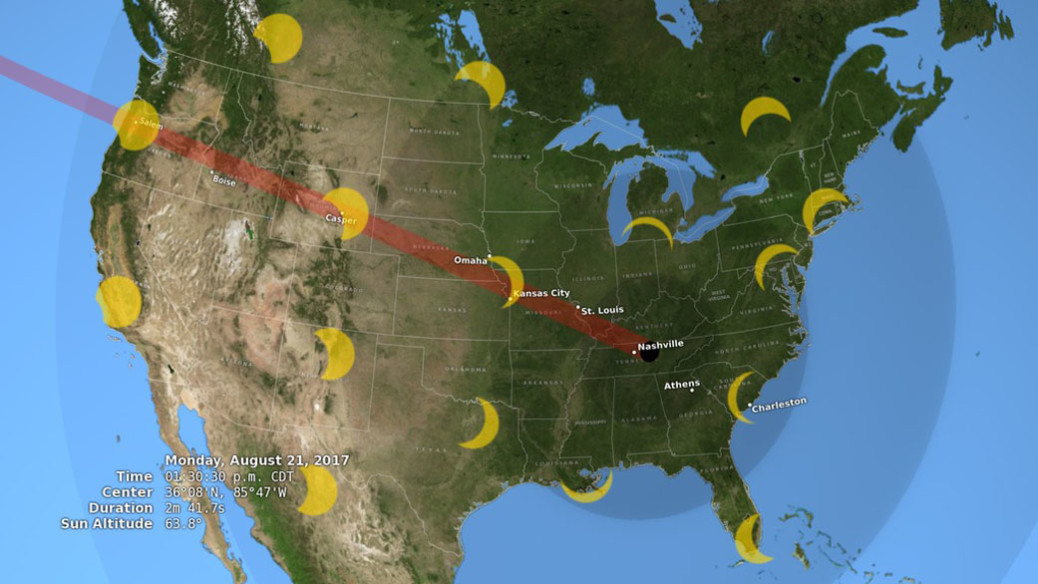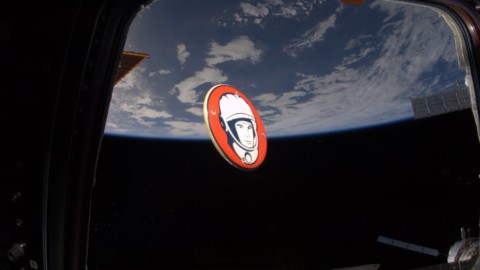August 21 marks a unique opportunity to see a total eclipse of the sun. During such an event: the Sun is completely occulted by the Moon; the entire sky takes on a twilight cast; and the blazing outer atmosphere of the Sun, known as the corona, becomes visible to the naked eye. The glowing corona is a spectacular sight, easily qualifying as one of the rarest natural events on our planet. Few people have seen the corona, and this is because a total eclipse recurs in a given location not less than once every 360 years. Thus to see an eclipse, one must be willing to travel, often great distances, and to locations that are either inaccessible, subject to poor weather prospects, or both.
This summer’s eclipse represents a great opportunity for the simple reason that the eclipse track sweeps over North America. Touching land in Oregon, the Moon’s shadow takes a mid-day tour across the continental United States before heading into the Atlantic via the beaches of South Carolina. It will be quite a rapid tour—only 90 minutes in length—because Moon’s shadow never slows to less than 2,300 kilometers per hour as it passes over the United States. The trick is to find a spot beneath the Moon’s shadow, one where the weather prospects will be favourable for the entire 2.5 minutes of totality. A nice animation can be seen here:
https://www.nasa.gov/feature/goddard/2016/preparing-for-the-august-2017-total-solar-eclipse
One reason so few people have seen a total solar eclipse is that the path of totality is delineated by the narrow track of the Moon’s umbral shadow, typically about 130 kilometers in width as it races across the Earth’s surface. Outside that narrow band, one sees only a partial eclipse, with the elusive corona being completely invisible. The following map illustrates the detailed geometry of the 2017 eclipse track:
http://eclipse-maps.com/Eclipse-Maps/Welcome_files/2017_LongMap_125dpi.jpg
The second reason so few people have seen a total eclipse is that the sky must be clear for those precious few minutes that the Moon’s shadow passes overhead. Canada’s own Jay Anderson is both an eclipse chaser and weather guru, and his wisdom has guided eclipse-goers for decades. His eclipse weather overview can be found here:
http://eclipsophile.com/overview/
Clearly the western half of the continent has the best weather prospects. That said, one must keep in mind that even with good planning an errant cloud can scuttle an entire expedition. I came very close to such a fate, in 1991, during the total eclipse in Baja, Mexico.
Total eclipses attract a fanatical group of eclipse chasers. Many of the best camp sites and motel rooms for this year’s event were booked long ago. Indeed, for the Baja eclipse all the hotel rooms were taken two years in advance. This does not mean it will be impossible to find accommodation, but it does mean that you must devise a plan right now, perhaps booking your accommodations some distance from the eclipse track, and driving down into the path of the eclipse on the day of the event. Preliminary estimates are that as many as 7.4 million people will travel to see the eclipse:
http://earthsky.org/astronomy-essentials/traffic-congestion-predictions-maps-eclipse-august-21-2017
Is it worth the trip? Only you can decide. There are several useful resources. The major astronomy magazines (Astronomy, Sky and Telescope, and Canada’s own SkyNews) all have special issues devoted to this eclipse, and you can find them on newsstands now. Astronomy magazine, in particular, has a very nice set of maps should you want to take a driving trip. As well, the “All American Eclipse” guide is a useful overview of everything you need to know:
http://www.colorado.edu/fiske/sites/default/files/attached-files/2017-eclipe-guide-web_final.pdf
What is clear from the map, on page five of the guide, is that everyone in North America will see a partial eclipse on August 21. Depending on where you live in Canada, you will see at least half the Sun blocked out by the Moon. That’s worth a look, but it also means you MUST acquire proper eye protection. The time to do that is right now. Supplies of eclipse glasses are already running out, and will probably be non-existent in the week prior to the eclipse. I do note that both the special issue of SkyNews and the special eclipse viewing issue of Sky and Telescope include a free pair of eclipse glasses. Eclipse viewers are also available on the SkyNews website.
Many Canadian dealers—listed at the top of the following AstroBuySell website—probably carry eclipse glasses too:
http://www.astrobuysell.com/propview.php
Other sources include Thousand Oaks Optical and Rainbow Symphony, which have been providing safe eclipse filters for years. I cannot over-emphasize the importance of using proper eye protection; a burned retina is to be avoided at all costs. That said, for those on the eclipse track, no eye protection is required during the period of totality—hence the splendid corona—and one should set alarms indicating the onset and disappearance of totality as a reminder to the window of safe viewing.
The last total eclipse visible in North America occurred in 1991. The next will cross southern Ontario on April 8, 2024. While the 2024 eclipse certainly looks promising, I am less than impressed with the weather prospects at that time of year. Want to wait a little bit longer? Your next chance occurs in western Alberta on August 23, 2044.
https://www.greatamericaneclipse.com/future/
My advice: don’t tempt fate in 2024. This summer’s eclipse is the one. And wherever your circumstances place you, make sure you’re looking up—safely—on August 21.
Dale Armstrong








